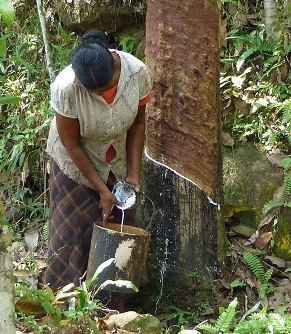Natural rubber prices have continued to ramp up with gains averaging around 20% since the turn of the year, according to ERJ’s latest snapshot of Far East markets.
 On the Shanghai Futures Exchange, the closing price for Ru1705 – the most heavily traded NR future – stood at Yuan21,475 /tonne on 2 Feb, 17.8% above the level recorded at the end of last year.
On the Shanghai Futures Exchange, the closing price for Ru1705 – the most heavily traded NR future – stood at Yuan21,475 /tonne on 2 Feb, 17.8% above the level recorded at the end of last year.
And on Japan’s TOCOM exchange, the back-month price for reference RSS3 materials lifted by 15.4% to Yen315.5/kg in the trading weeks between 1 Feb Nov and 4 Jan, while the near-month reference price rose 23.9% to Yen334.0/kg.
In Bangkok, prices for RSS1 and RSS3 grades each increased by around 27% – to $287.85/100kg and $284.55/100kg respectively – between 30 Dec, 2016 and 2 Feb.
Kuala Lumpur prices for SMR-20 increased by 20.5% to $237.35/100kg over the same trading period. Latex prices, meanwhile, were up by 28.1% to $186.95 as of 2 Feb.

Commenting on the latest price developments, Dr Prachaya Jumpasut of The Rubber Economist, linked the rapid increases over recent months to a variety of short-term factors, as well as currency and oil-price movements.
These factors, he noted, included unseasonal and heavy rain and flooding in the southern part of Thailand and an increase in speculative trading in China and Japan.
“Any news of an interruption to rubber production, particularly to the largest producing country Thailand, would certainly cause an increase in speculative rubber futures trading in Shanghai and TOCOM,” said Jumpasut.
And, he noted, even news of labour shortages in the fifth largest producing country Malaysia, since the government has stopped allowing foreign workers into the country, “has made the speculators anxious of the possibility of a [rubber] shortage.”
Meanwhile, The Rubber Economist is reducing its forecast of the Thai rubber output for this year because of the weather problem. But even before the floods in Thailand, it had predicted the world NR balance to show a negative for this year.
This, the market analysts believe, will bring global stocks and stock/consumption down slightly, but not fast enough to support a long-term trend of steady and rapidly increasing rubber prices.
So while rubber prices may continue rise further as long as weather problems persist in Thailand, Jumpasut concluded: “Fundamentally, the absolute level of stocks and the stocks in relation to consumption are still at a relatively high level when compared to the historical standard despite their current declining trends.”


























